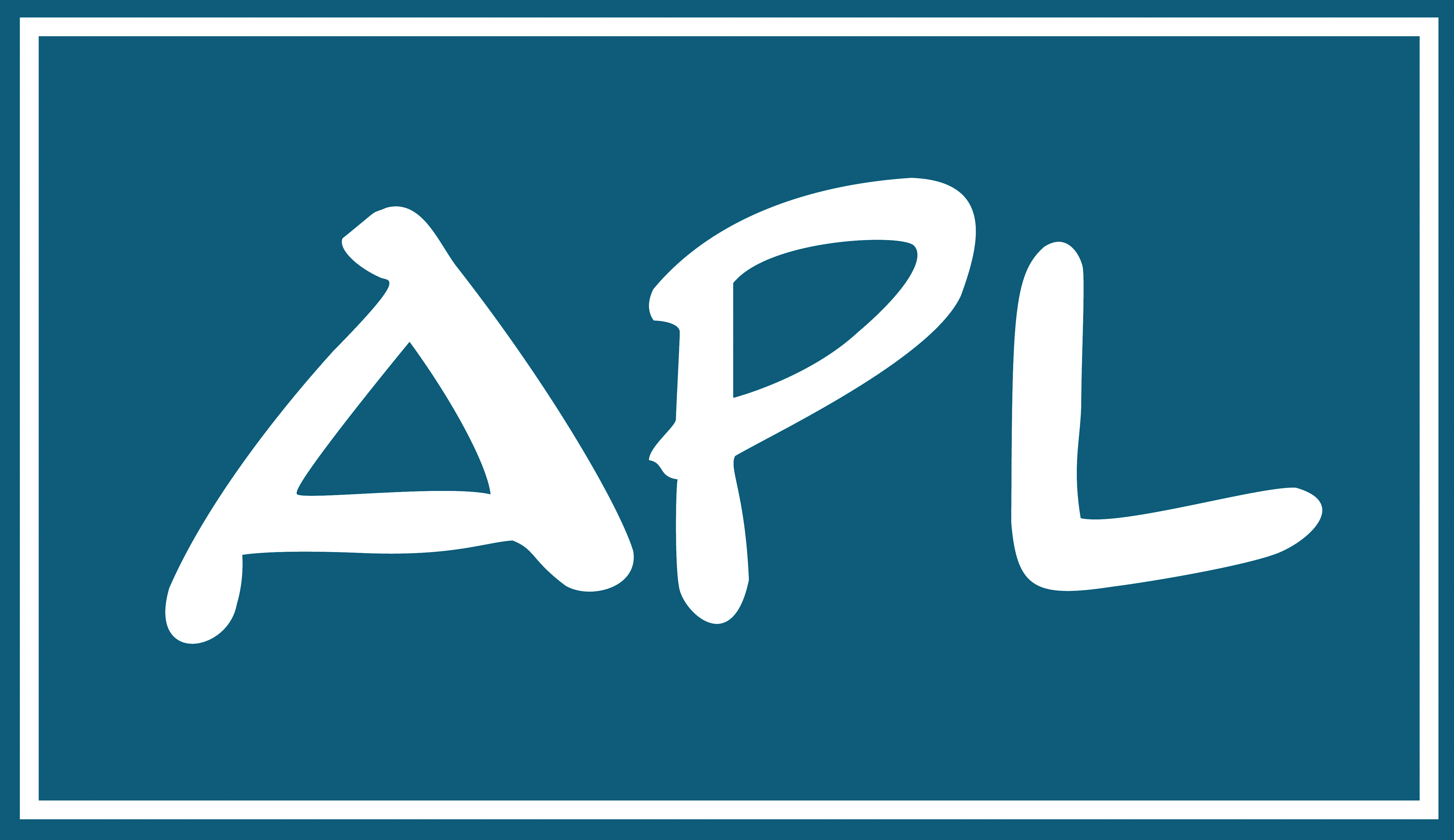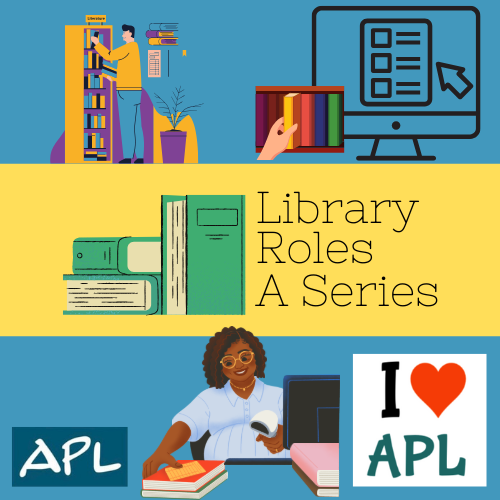The library Collections + Catalog Specialist demonstrates an in-depth knowledge and expertise in one or more areas such as acquisitions, circulation, collection maintenance, and cataloging and metadata creation. The Collections + Catalog Specialist at the Antigo Public Library is Elizabeth Simek. Elizabeth is responsible for cataloging all new materials added to the APL collection into the virtual catalog technology system (V-CAT). She is responsible for weeding the collection according to the APL Policy on Collection Development. She is responsible for running regular reports of patron circulation and using that information to order new books and media inventory for the APL Collection.



Elizabeth was hired as a part-time employee at the Antigo Public Library in 2006. Her job was to help process all library items so they could be checked out. The director at the time wanted her to train at the circulation desk, so she did that as well. In 2010 she was asked to split her time between the White Lake Branch Library and the Antigo Public Library Main Branch. While working in White Lake Elizabeth helped bring the branch online and increased circulation. Bringing the branch online allowed the residents of White Lake to have access to the whole of the WVLS consortium catalog and have their hold requested items delivered to the White Lake Branch. Between 2010 – 2015 White Lake Branch circulation increased 400%. In 2010 Elizabeth started classes in Web design and development, C++, and computer networking. Upon successful completion of those classes she worked with the library director to create the first version of the Antigo Public Library’s website: antigopl.org. In December of 2015 she was hired full-time for the Outreach position. She delivered library items to the residents of Langlade County who could not come into the library. She visited the nursing homes, assisted living facilities, and Meals on Wheels site in Elcho and White Lake. 2015 was also the year that Elizabeth began cataloging and purchasing large print and paperback books for the library. She went through the catalog training at WVLS to do this. She was asked to represent the Antigo Public Library on the WVLS Bib Committee in 2023 (Bib referring to bibliographic records). In the fall of 2024, her title changed once more to the Catalog + Collections Specialist. She now catalogs all items that the Antigo Public Library patrons check out.
Library cataloging goes back to Ancient Mesopotamia, around 2000 B.C.E. when clay tablets recorded information and were stored and cataloged by title and subject. The Dewey Decimal Classification system was developed in 1873 by Melvil Dewey, an American librarian. The system was created to simplify subject cataloging allowing libraries of all sizes to organize their collections. It was published in 1876. “In the 1960s, the Library of Congress initiated the MARC (Machine-Readable Cataloging) program, creating a standard for digitizing bibliographic information.” (Webb, W. (2023). It is the MARC system that allows for consistent organization in Virtual Catalogs such as V-CAT shared by all WVLS (Wisconsin Valley Library Services) that allows us to easily find and request books from other libraries for patrons.
Cataloging Uncovered: Mastering the Art of Library Organization by William Webb (2023) discusses the importance and purpose of library cataloging as follows:
“When you consider a library, whether it’s a small local branch or the grand Library of Congress, think about the thousands – or even millions – of items housed within its walls. Books, periodicals, CDs, DVDs, digital resources…without an organized system, finding a particular item would be akin to finding a needle in a haystack. That’s where cataloging swoops in to save the day. It serves as the organizational backbone of a library, transforming a chaotic jumble of resources into an orderly, accessible collection. At its heart, cataloging is about making information discoverable. It enables library users to find the resources they need quickly and efficiently. Without proper cataloging, even the most comprehensive library collection becomes essentially useless. It’s like having a treasure chest with no key. Cataloging provides that key, unlocking access to the wealth of information a library holds. The process of cataloging involves the creation of accurate bibliographic records, which include detailed information about each item in a library’s collection. These records serve a dual purpose: describing the items and providing access points. The description enables librarians and users to understand what an item is, while access points (such as author, title, or subject) allow for the discovery of items through searching. The purpose of cataloging extends beyond making library collections accessible. Catalogs also help manage collections, assisting librarians in maintaining the library’s resources. They enable librarians to track what items the library has, where they are located, and how often they are used. This can guide collection development strategies, ensuring the library meets the evolving needs of its users. Cataloging isn’t just about serving individual libraries. It plays a vital role in connecting libraries globally. Shared catalog systems, like WorldCat, enable libraries to share bibliographic records, saving time and resources. These systems also link libraries, creating a global network that enables users to locate materials held in libraries worldwide. It’s clear that the significance of library cataloging is multi-fold. It’s about organization, accessibility, management, collaboration, and even acts as a bulwark against the tide of misinformation.”
“Cataloging involves creating detailed records for items in a library collection. Cataloging encompasses a multitude of tasks, from describing physical attributes of a book to determining its primary subject. At its core, cataloging is all about making library materials accessible.” (Webb, W. (2023) p.15). “Think of cataloging as the process of creating a detailed road map for each item in a library’s collection. This road map is known as the bibliographic record. Cataloging is the comprehensive process of creating, organizing, and maintaining bibliographic records, which ultimately make a library’s collection accessible and navigable. Classification is the process of assigning each item a label, usually a combination of letters and numbers, that corresponds to its subject. This label, often referred to as a call number, not only guides users to the item’s location on the shelf but also groups it with other items on the same or related subjects.” (Webb, W. (2023) p. 16). “Classification systems, such as the Dewey Decimal Classification or the Library of Congress Classification, create a logical structure. The hierarchical nature of these systems enables users to find both the specific information they need and explore broader or related topics. Classification brings order to what could otherwise be an overwhelming array of resources.” (Webb, W. (2023) p. 16-17).
Together, cataloging and classification make a library collection “accessible and user-friendly.” (Webb, W. (2023) p.17). “Cataloging and classification are not simply administrative tasks; they involve thoughtful decision-making and critical thinking. Catalogers need to consider how users will search for items and make decisions that will aid these searches. When classifying an item, the goal is not just to find it a spot on the shelf, but to place it within the context of the whole library collection.” (Webb, W. (2023) p.17).
“The bibliographic record is the cornerstone of cataloging, the vital link between a library’s collection and its users. It’s what allows a person to find and identify a specific item within a vast sea of resources. At its core, a bibliographic record is a detailed description of a library item. It’s the cataloger’s way of telling the user, “Here’s what this item is, here’s what it’s about, and here’s where you can find it.” (Webb, W. (2023) p. 21). Bibliographic records are very important. “They do much more than just describe items. They facilitate access. They enable discovery. They provide a structured, predictable way for users to navigate the library’s collection. In doing so, they turn a mere collection of items into a resource, a tool for learning, research, and enjoyment.” (Webb, W. (2023) p.23). “Descriptive cataloging, as the name suggests, is the process of creating a detailed description of a library item. This description forms the backbone of the bibliographic record, providing the essential details that help users find and identify the item. It’s akin to crafting a snapshot of the item, capturing its most salient features for users to explore. The goal of descriptive cataloging is twofold: to enable users to find items that match their search criteria and to help them identify whether a specific item meets their needs. (Webb, W. (2023) p.24). Just as descriptive cataloging helps users find and identify items based on their physical attributes, subject cataloging helps users find items based on their content. It’s an integral part of the cataloging process, aimed at unlocking the richness of the library’s collection and making it accessible to users.” (Webb, W. (2023) p.26-27).
“Descriptive cataloging and subject cataloging are like the two sides of the same coin. Descriptive cataloging allows users to identify and select items based on key attributes, while subject cataloging enables them to find items based on their areas of interest or research. Together, they create a comprehensive picture of each item, making it possible for users to locate, identify, select, and obtain the resources they need. This combined approach not only enhances the user’s experience but also amplifies the value of the library’s collection. By detailing both the physical attributes and the intellectual content of each item, we ensure that every resource – be it a book, a DVD or a digital document – can be fully discovered and utilized.” (Webb, W. (2023) p.30-31).
“The accuracy of bibliographic records forms the bedrock of our cataloging work. We’ve all experienced the frustration of trying to locate a book or article, only to find the catalog record contained incorrect or misleading information. When records are inaccurate, it creates roadblocks in the path of information access.” (Webb, W. (2023) p.108-109. Here at the Antigo Public Library we have been dealing with many inaccuracies in our catalogue. Between January 2023 through April of 2024 more than 13,000 books and media were “weeded” from the APL collection by the former director and library services manager Much of those materials were sold by the bagful for $1 a bag. During that process some books were deleted from the system and left on our shelves. This has resulted in patrons bringing books to the circulation desk to check out only for staff to discover that there is no corresponding record for the barcode on the book in V-CAT. The book then has to be re-cataloged into the system. There are also books in the virtual catalog that are no longer on the shelves – books sold but not deleted from the system. When all of the clean up and re-organizing in the library is complete, staff will undertake a full inventory of the APL collection to resolve these inaccuracies in our collection. In the meantime we are deeply grateful for the patience of patrons who have to wait a few minutes longer for a book to be re-catalogued into Sierra (our V-CAT system) or ordered from another WVLS branch because our copy is missing.
“Accuracy in cataloging isn’t just about getting the facts right. It’s about providing a true representation of the resource. From the physical description to the subject headings, each piece of information paints a picture of the resource for the user. If our picture is inaccurate, users may miss out on valuable resources.” (Webb, W. (2023) p. 109). As an academic, this is everything. There are millions of books, journals, and articles in existence and available in online catalogues – whether those are in libraries or databases like JSTOR. Being able to find the materials that you need, want, are interested in, is paramount for ensuring equitable access to information for all.
“Library catalogers, often the unsung heroes, have a profound impact on how the library functions and how users interact with the collection. They’re the architects of the library’s cataloging system, ensuring that the organization, accuracy, and accessibility of information are top-notch. A cataloger’s work creates the roadmap users follow to discover the resources they need. That’s why it’s crucial to understand the cataloger’s role in shaping the user experience. The foremost responsibility of a cataloger is the organization of information. This involves assigning specific call numbers to materials based on an established classification system like the Dewey Decimal System or Library of Congress Classification System. Each resource’s call number is like a home address, helping users locate it on the shelves. Creating bibliographic records is another critical task. This process involves detailed cataloging of resources, describing their content and structure. It also includes creating metadata – data about data – that makes it possible for users to search for resources effectively. Catalogers ensure that each item’s bibliographic record accurately reflects its content, format, and physical characteristics. They assign subject headings and sometimes create abstracts or summaries, providing users with a concise overview of the resource’s content. They standardize names and subject headings which brings consistency to the catalog and makes it easier for users to find all resources related to a specific topic or by a particular author. Maintenance of the catalog is a regular part of a cataloger’s role. This involves updating records when items are moved, removed, or reclassified. Library catalogers are also responsible for staying current with evolving cataloging standards and technologies. As new materials and formats emerge, catalogers must adapt and learn new methods of cataloging these resources. Catalogers create connections, making it possible for users to find the information they need, when they need it, and in a format that suits them.” (Webb, W. (2023) p.117-119).
“The library community has long recognized that children have their own unique characteristics and requirements as library users. Special bibliographic treatment of library materials is warranted to meet their needs. A cataloger should know how to search, edit, copy, create, and download records in a local online catalog. The content of the bibliographic record is created using international cataloging rules, with layers of rule interpretation and application. Content may also be created based on the needs of the local library community. The structure for a cataloging record is provided through use of the MARC format. The content choices and decisions for the record are created through application of the current cataloging code, RDA (Resource Description and Access). RDA was introduced in 2010 but not implemented until 2013. Even though RDA has been in use for more than a decade, catalogs still contain many records that were created by earlier standards. As a result, catalogs can be a mixture of old – and new- looking records. Today’s cataloger needs to know what cataloging elements to embrace, what to ignore, and what needs to be updated.” (Zwierski, M. (2021) p.45-46).
“The goal (of cataloging) is to help your patrons find what they are looking for. The only thing you should do is what makes the most sense for your readers.” – Linda Hoiseth, July 13, 2020, teacher-librarian at the American Embassy School in New Delhi. According to Linda, “A picture book is often defined as a book where the illustrations are as or more important than the text in telling the story. (That makes it different from an illustrated book, which could tell the story without the pictures, but the pictures add to the experience.) Many picture books are 32-pages long. Picture books may be complex because they are intended for adults to read to children, or they may have simple text for emerging readers to read on their own.” In an interview for the Community Library Project, Linda was asked, should picture books be further divided into fiction and non-fiction? Her response was, “It depends!” Her response was based on usage, research or general interest. If general interest, they do not need to be divided. Her reasoning, “if patrons aren’t looking for an answer to a research question, but rather are looking for something interesting to read, then they might be just as interested in a non-fiction picture book about cars as they will be about a fiction book about fairies.” (Hoiseth, L. (2020)). When asked, in the same interview, how to group books, she responded, “the only thing you should do is what makes the most sense for your readers.” (Hoiseth, L. (2020)).
We have been making changes to both adult and children’s organization of materials. In the adult department we are restoring the genre sections: fiction, mystery, SyFy + Fantasy, Manga & Graphic Novels, and Westerns. We are creating new sections: Wisconsin Fiction & Wisconsin Non-Fiction. The Young Adult non-fiction and manga & graphic novels are being pulled out of the adult sections (a form of soft-censorship) and being returned to Young Adult. The juvenile non-fiction are books aimed at ages 7 years to 13 years, or 2,000 – 40,000 words in length. Non-fiction picture books are being returned to the picture book collection with categories by subject. An approach that makes it much easier to find a subject. Easy-reader non-fiction books are being returned to the easy-reader collection. Browsing it wonderful. Individuals can browse no matter the organization approach. The Aspen catalog system that patrons can search online from our website – searchable from a computer, tablet, or phone, is accessible in the library. Staff are always available to help patrons find books they are interested in. Any weeding done, is now done according to the updated Collections Policy. No book has been challenged for removal at the Antigo Public Library. Every patron should be able to find the books they want with as much ease as possible on our shelves. That is the goal we are working towards.
Elizabeth is absolutely the Antigo Public Library’s unsung hero. Cataloging takes an enormous amount of time and care towards detail. She is invested in ensuring that the books purchased are what the APL Patrons want to read, that they are accurately cataloged in a way that makes them easy to find based on patron habits within the library. She orders patron requests, spending a great deal of time ensuring that if the format requested is available, she is able to get it for the patron. When the format is unavailable – not all books are made into Large Print or Audio books on CD, she takes the time to explain to the patron why we are unable to get their requested item. In addition to cataloging and purchasing she also goes to the Langlade County Senior Center each Tuesday from 11AM – 1PM to provide Tech help for seniors in our community. As well as providing one-to-one patron appointments for Tech help in the library. Elizabeth is an asset and a wonderful resource for the Antigo Public Library. We are grateful for her nineteen year career with the library. We look forward to celebrating 20 years of service with her in 2026.
If you would like to read more on cataloging I recommend the following resources:
Webb, William. (2023). Cataloging Uncovered. Mastering the Art of Library Organization. Publisher unknown.
Zwierski, M.; Fountain, J. F.; McCroskey, M. (Ed.) (2021). Cataloging Correctly For Kids: An Introduction to the Tools and Practices. American Library Association.

